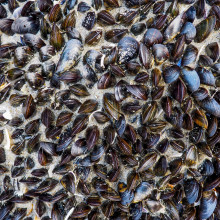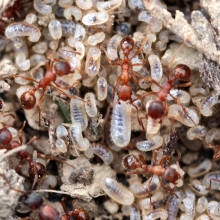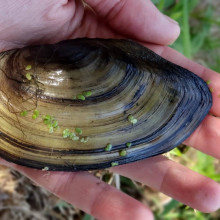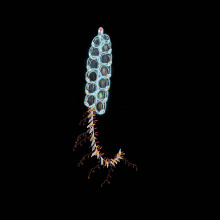New Alzheimer's treatment, and mussel memory
A new Alzheimer’s drug shows some promise in trials, but are the risks from side effects worth it? A new contraceptive inspired by Roman history and shellfish… And the surprising discovery about ants that scientists missed for over a century…
In this episode

00:54 - A breakthrough in Alzheimer's treatment
A breakthrough in Alzheimer's treatment
Charles Piller, Science Magazine
As life expectancy rises, more people are living to an age when degenerative diseases like Alzheimer's become a problem. And in recent decades the pharmaceutical sector has been pursuing various approaches to try to slow down or halt the disease. This week the Japanese company Eisai announced the results from a phase 3 clinical trial on nearly 2000 people in the early stages of Alzheimer's comparing their new drug lecanemab against a placebo. The drug is a modified antibody that works like a sponge to soak up and reduce the build-up of a protein called "beta-amyloid" that accumulates and kills nerve cells in the brains of people with Alzheimer's. In the trial, after 18 months on the drug, participants showed a 27% slower rate of progression of their Alzheimer's symptoms, but they still worsened all the same. So it's certainly not a cure, and it's going to be a tricky call for regulators and health funders to judge whether, in this case, the pill is better than the ill, because as well as being costly, there were also some serious side effects, including fatal brain haemorrhage...
Charles - My name is Charles Piller and I'm a journalist with Science Magazine. This study that I wrote about is regarded by many as one of the most promising developments in the field in a long time. And it involves an antibody that is used to bind to certain deposits of proteins in the brain that many people think are responsible for Alzheimer's disease. And so by using this antibody, the hope is that it would arrest or even reverse eventually the effects of Alzheimer's disease. In fact, in this experiment, they found that it did not do those things, unfortunately, but they decided that it had an effect of slowing down the cognitive decline. In other words, the people who received this drug continued to decline in their cognitive abilities, but a little bit more slowly than those who had the placebo. So this, in the curious world of Alzheimer's research, is regarded as a great success. Obviously it doesn't sound like a wonderful gigantic development, but it's something people could hang their hats on.
Chris - With any drug though, there are always side effects. And in this instance, you are pointing out that there was the most dramatic side effect of all in one particular recipient.
Charles - Yes, this is a case of a woman who received this drug and after three infusions of it, she had a stroke and was treated with something called TPA, which is a very powerful anticoagulant that people are often given immediately after they have a stroke. In the vast majority of cases, it's very successful in mitigating the effects of a stroke. So she was given TPA, but what happened was the combination of lecanemab, the drug she was given in the trial and TPA combined to cause a massive brain hemorrhage and caused death in horrific circumstances. These are not my judgements about what happened. These are the judgments of the neurologists and the pathologists, the person who did the autopsy. They concluded based on their scientific analysis and on the autopsy that this is what happened.
Chris - Strokes are very common, especially in older people, as is Alzheimer's disease. So how do we know that the drug for Alzheimer's disease caused the susceptibility to this bleeding that the stroke agent caused? Is there a mechanism that would explain this?
Charles - Yeah, there is a very strong scientific mechanism. So I mentioned before that one of the characteristics of Alzheimer's disease is deposition of plaques, proteins that stick to brain cells and also to the blood vessels. What happened in this case is this woman who had the stroke also had a condition called cerebral amyloid angiopathy, and it's a condition that causes a lot of plaque to build up around these blood vessels that serve the brain. And when she was given this drug lecanemab, what scientists believe is that it stripped away a lot of those plaques, and in so doing caused those blood vessels to become inflamed and weakened and when the TPA was given, they burst.
Chris - What are the implications of this then? Is this a show stopper for lecanemab, the drug in question?
Charles - The US Food and Drug Administration here, and also your regulatory bodies will be evaluating that very question. However, what we do know is that there is long standing concern about this type of drug being used with any kind of blood thinner that had been associated with very bad brain bleeds in people who are taking this drug and similar antibody drugs for Alzheimer's disease. So we're waiting to see if the makers of this drug lecanemab are going to be suggesting to regulators that it shouldn't be given to people who are on blood thinners or who might be prescribed blood thinners in the case of a stroke. And it kind of creates a terrible dilemma for some patients. So what we don't know is what precautions could be taken and what warnings could be given. And I think we'll hear more today actually at a big meeting where the maker of the drug, Eisai, which is a Japanese company, is going to be talking about the results of their clinical trial. And I'm hoping, and many people are hoping that they will address this question of brain bleeds and blood thinners directly.

07:03 - New contraceptive found in shellfish
New contraceptive found in shellfish
Bill Colledge, University of Cambridge
A new contraceptive inspired by Roman history and shellfish is being investigated by scientists in Sweden. Many women currently use the birth control pill, but some would prefer to prevent pregnancy without altering their hormones. Ulrike Schimpf has been developing a way to use the substance chitosan - a sugar-based molecule that comes from the outer skeletons of animals like shellfish - to reinforce the natural mucus barrier which forms in a woman’s cervix and can temporarily block the passage of sperm. Professor of Reproductive Physiology at the University of Cambridge, Bill Colledge, has been looking at the study results for us…
Bill - They have effectively developed a barrier method to prevent the sperm from reaching the egg and causing fertilisation. And they've used a substance called chitosan, which is a very long sugar molecule. And it's actually derived from chitin, which is present in the exoskeleton of insects and crusta. And what the substance does is it binds to mucus within the female reproductive tract and it effectively plugs the entry of the cervix. But interestingly, it's been known for a long time, the Romans used to use half a lemon placed up against the cervix as a type of diaphragm to block the penetration of sperm. And they use this as a contraceptive.
James - What is it about the chitosans that make them so fit for this purpose?
Bill - They're natural substances and they've been used in a variety of different applications, including clinically. So there's a lot known about their safety and efficacy. The mucus within the vagina does change throughout the menstrual cycle, and some people use this as a normal form of contraception. They monitor the mucus, it's called the billings method. And what women can do is they can monitor the viscosity of the mucus throughout the cycle. And at the time when they're ovulating, the viscosity changes and it becomes more sort of like it's described as egg white. And at this time the sperm can actually penetrate through the mucus and can get through the cervix and can reach the egg. So effectively what this study is doing is adding something into the vagina that will bind to the mucus, change its thickness, and therefore stop the sperm from penetrating.
James - You mentioned that this is a barrier method of contraception. I wonder if I could ask you the benefits of barrier methods over different methods of contraception, more hormonal based ones?
Bill - It's going to have less side effects. So women take the contraceptive pill, which is either progesterone or progesterone, a little bit of estrogen, mood changes and things like this. Whereas this is not going to cause that there's no hormones involved.
James - I mean, it's all sounding very promising. Is there anything that you notice that might halt our enthusiasm?
Bill - Well, the authors discuss the various caveats and the limitations of the study. Obviously it's very early stages. One of the main caveats is that the work that they did was done using a female sheep as a model, and the vagina and the cervix of the sheep are slightly different from the humans. So there may be some differences when they tried to translate it into doing it in women. They also point out that they haven't taken into account the effects of sexual intercourse, which is a very physical thing, so that might limit its efficacy. The other thing that they don't look at is how long it lasts. So they administer it and one hour later they show the effects. And I think the effects certainly last four hours, which is the limit of the study, but they don't know how long it'll last thereafter. So I think they're probably going to, if you use this, you may have to use it prior to any sexual intercourse, every time.
James - And a 98% efficacy rate. Could you contextualize that against other contraceptive methods?
Bill - The hormonal contraceptive methods are very effective. They're up in the 90% if used correctly, so it's as effective. Of course, they've only shown that it blocks sperm. They haven't looked to see whether it affects the ability to get pregnant. So although 98% sounds very, very effective, you're still gonna get 2% of the sperm penetrating. And of course, you only need one sperm and one egg to result in fertility. So until they actually check what effect it has on fertility and live births, we don't know whether that'll be sufficient. But by analogy to the hormonal contraceptives, which are of a similar sort of efficacy, you would think it would be as effective.

12:28 - Ant pupae feed adult ants and larvae
Ant pupae feed adult ants and larvae
Daniel Kronauer, Rockefeller University
Scientists and naturalists have been fascinated by the industry and organisation of ants for hundreds of years. And we thought we knew most of the basics about how they organise themselves and their colonies. So how did we overlook the fact that developing “baby” ant pupae feed the adult ant workers and other developing ants with a milky substance that appears to be critical for their survival? In an extraordinary reversal of the breast feeding process adopted many mammals like us, the pupae secrete this milky substance that other ants consume. Daniel Kronauer, at Rockefeller University, discovered it…
Daniel - So it turns out that this fluid is actually the malting fluid of the pupae. The moulting fluid is a fluid that all insects actually produce because they have to shed their exoskeleton, their skin in order to grow. Most solitary insects reabsorb and recycle this moulting fluid. But now it turns out that the ants actually secrete it. Normally in solitary insects it kind of accumulates in the space between the old exoskeleton and the new cuticle, the new exoskeleton. In the ants, it's secreted and it kind of leaks out of the rectal opening of the former cuticle. So it kind of accumulates a droplet at the abdominal tip of the ant pupae.
Chris - What happens then? The other ants come along and collect it?
Daniel - Exactly. That's what happens. So the adults, they drink it as it accumulates, and on top of that, they also bring the larvae of the ants, which in ants can't really move independently. The adults carry them and place them on top of the pupae. So the larvae also lap up this liquid as it gets secreted.
Chris - And you can prove that they're actually not just cleaning this up, because there's a danger obviously if you end up with this stuff accumulating and if it's rich in lots of potential food, then it's going to feed microbes and things and that could cause disease. So are you sure that the animals are eating this?
Daniel - You're absolutely right because the fluid is very rich in nutrients, it can lead to fungal growth and actually if the fluid does not remove the ant pupae die of fungal infections. And so the way we showed that the larvae and the adults actually drink it is we injected food colouring into the pupae into this fluid. And then we could show by tracing it into the adults and the larvae actually take up the fluid.
Chris - And do they actually incorporate it into their own bodies? They're not just taking it up in order to then regurgitate it and dump it somewhere. They're actually using it?
Daniel - Yes. So they're using it, they're digesting it. And we could actually show that the young larvae really depend on this fluid for growth and survival. So if the young larvae don't have access to this fluid, they don't grow well and the mortality really increases compared to a lot of that have access to this fluid.
Chris - Does it have any role beyond just nutrition? Does it have any role in terms of determining who is who because there is a hierarchy in these sorts of organizations of social insects, isn't there, where there's the queen who's laying eggs and dictates the behavior of other workers with various pheromones and so on. So does this have any role to play in that sort of role determination system?
Daniel - So that's something we're very interested in for future research. It's something that we haven't studied yet explicitly, but because this social fluid is really rich in hormones, which we know are important for the development of ants into queens and the workers for example. So for example, one compound that we found in this fluid is also very prominent in the royal jelly that honeybees feed to larvae that they want to wear into queen honeybees. And that seems to be important in determining queen development. And so it seems like a good hypothesis that we want to follow up on.
Chris - And you raise a good point about bees because they're the other major group of social insects that we think about a lot. Do they do anything like this?
Daniel - Yeah, this was an interesting question that we actually also asked ourselves and we decided in the end to get a few bees into the lab and took honeybee pupae and put them in social isolation to see whether they secrete the fluid. But it turns out that honeybees don't. So we don't know yet whether maybe other social insects do something similar, like wasps or so on, but at least the honey bees don't. And I think one reason might be that honey bees of course develop in these combs, so they're like enclosed in a cell. Maybe the adults have less of an access to the pupae in ants. So it's very different. Ants don't build combs like honeybees do.
Chris - Have you any idea how this evolved in the first place? One approach might be to look at the fact that there are thousands, I think I read somewhere, 15,000 different species of ant. And if they all did it then it must be a very ancient behavior that got going very early in their evolution. So where did they get this from?
Daniel - Yeah, that's another very good question. There's many, many ant species, as you said, about 15,000. We initially found this in our main lab model system, which is called the clonal raider ant. But that species is a little bit unusual. And so what we did is we got another four ant species that kind of covered this biodiversity of the ants phylogenetically. So they're all very distantly related ant species. And it turns out that they all secrete this pupal fluid. And so it seems like this evolutionary novelty really arose very early in ant evolution. And so it's a very ancient thing and we think it has probably been very important for the early evolution of social behavior and ants because it creates these dependencies across different developmental stages, right? And it really helps integrate this ant colony superorganism like structure where individuals are really dependent on other individuals in the colony.

18:13 - Mussel Memory: Repeating a 65 year old study
Mussel Memory: Repeating a 65 year old study
Isobel Ollard, University of Cambridge
To the aquatic realm now, and mussel numbers are a good indicator of the health of a river. And Cambridge University zoologist Isobel Ollard set out to replicate a study from over half a century ago on a stretch of the River Thames near Reading to see what had changed. Alarmingly, mussel numbers were down 95%, with some species disappearing completely…
Isobel - Muscles are one of the most threatened animal groups globally. But in the UK we really have very little information about how they're doing. And this study, which we replicated, was carried out in 1964 and it was one of the first properly quantitative surveys of muscle populations anywhere in the world. And it found, for example, that freshwater muscles contribute over 90% of the biomass in the river Thames, in the riverbed. So we wanted to return to that site and use the same survey methods, find out what's changed in the intervening period.
James - And other than that headline stat of 95% population decrease, what were the other key findings of your study in comparison to that one 50 years ago?
Isobel - So we found that one species, the depressed river mussel, has disappeared completely from the site. So although we found a few shells, we didn't find any live muscles of that species. And two other species have declined really sharply. So the duck mussel is down 99% and the Painter's mussel is down 97%. And those are both species, which are typically seen as common. We also found that individual sizes in the muscles have changed. So they're growing more slowly now than they were in 1964 and they're reaching sizes which are about 10 to 35% smaller than they were nearly 60 years ago.
James - All sounds quite worrying.
Isobel - Absolutely, yeah. And really for two reasons. So the first being that mussels are often viewed as indicator species about the health of an ecosystem. So if mussels are declining, that's kind of bad news, which suggests that the habitat quality more generally is probably deteriorating. And the second reason is that mussels are really important in the ecosystem. So they're described as ecosystem engineers because of the roles that they play in underpinning the ecosystem more widely. So they're filter feeders. They take in algae and other organic particles from the water column and help to keep the water clear and a single muscle can filter up to 40 liters of water in a day. So you can imagine the amount of water filtration that's going on across the river and we know that having a high density of muscles is associated with high riverbed biodiversity.
James - So what's the cause? What's behind this dramatic decline?
Isobel - One clear reason that we found is the fact that this site's been invaded by zebra mussels, which are a non-native species to the UK, which are now found in fairly high densities in the river Thames. And they weren't present at that site in 1964. And they're a really problematic invasive species so they can settle on hard surfaces, including on the shells of native muscles. And that means not only do they compete for food with those muscles, but they can also smother them and ultimately stop them from opening their shells at all. There's probably also been wider ecosystem degradation, so things like pollution. We also looked at the level of nutrients in the river and we found that the level of particularly phosphate has declined a lot in the intervening period and that's probably due to tighter controls around sewage releases. And while that's good for the ecosystem generally because less nutrients means less chance of developing harmful algal blooms, that could be potentially bad news for the muscles in that it means less food availability for the mussels and we think that might be contributing to their slower growth rates.
James - So what do you propose we do about this? Is there anything we can do about this?
Isobel - So I think one of the really key things that comes out of this is that we need more monitoring, especially for species which we think are common. We really have no idea how widespread this picture might be across the UK. In order to kind of pin down the causes and design better interventions and to conserve these species, we need to do more monitoring more widely and across more species.

22:28 - Swimming tips from a jellyfish relative
Swimming tips from a jellyfish relative
Kelly Sutherland, University of Oregon & Kevin Du Clos, University of Oregon
Biomimetics, a fancy term for when inventions mimic processes from the natural world, play a key part in our day to day lives. We have designed snow tyres based on the texture of a polar bear’s foot, and swim suits that mimic shark skin. And now, researchers at the University of Oregon think that the future of marine vehicle propulsion could be greatly improved by taking inspiration from a close relative of the Jellyfish - Nanomia bijuga. Kelly Sutherland and Kevin Du Clos spoke to Will Tingle about what makes this animal’s method of movement so special, and what it hopes to inspire for the future of marine vessel movement.
Kelly - So we've been studying jellyfish for quite some time and we've been studying jellyfish that just have a single swimming unit that swims by jet propulsion. So they pull fluid into their body and then they squeeze their muscle bands and push the water out the back end. And they have this smoke ring like locomotion. It turns out that there are jellies that actually have many swimming units. It's kind of like a bunch of small jellyfish strung together. And so it was sort of an obvious next step to start looking at jellyfish that have multiple swimming units. And it kind of opens up a whole array of interesting questions about what happens when you have distributed swimming units, what kinds of swimming modes does that open up?
Will - And Kevin, what are some of the benefits of having multiple jets instead of just one?
Kevin - Having multiple jets rather than just one, makes them more maneuverable so they can actually pulse just one jet, which can cause them to do a very tight turn. It makes them more adaptable. So they have redundancy. If one of the jets is not functioning, they swim essentially as well as they could with all the jets. And then for the case of this study, what we're interested in is they can vary the timing of propulsion by all the different jets. And so that allows them to swim in different swimming modes. So they have a swimming mode that's good for escaping predators, for swimming away fast. And they have one that's better for more routine swimming that requires less energy.
Will - Purely in terms of underwater vehicular design, how is this locomotion better than what we already have?
Kevin - What we suggested in this paper is that by changing the timing of thrust production, you could actually produce a vehicle with swimming modes that were well suited to different tasks. So without changing anything about the hardware, with just an underwater vehicle that has multiple propellers for example, just by varying the timing of thrust production, with software changes, you could have a vehicle switch from a high speed mode to an energy efficient mode. And so that's sort of an advantage in making a vehicle adaptable to circumstances.
Kelly - So in addition to the high speed swimming and the more economical swimming for long distance swims. In earlier work, we also looked at the maneuverability, and also swimming reversals in these colonies. So they have a really diverse array of swimming maneuvers. And the key to that is really having multiple propulsive units that are identical.
Will - We talk about underwater vehicles, but that seems a bit broad. Would you mind shedding some light on which vehicles you think would benefit most from this particular design?
Kelly - Vehicles that are small and maybe surveying something like a coral reef where there's a lot of nooks and crannies. This is a long, narrow design together with the maneuvering and the capability of swimming long distance or long distances economically, as well as maneuvering quickly. With this work, we're really fundamentally interested in the organisms and how they make a living successfully. And a lot of times there's lessons to be learned that can be applied in a design sense. And a lot of times what we're learning are really fundamental principles. So it's not so much about designing a vehicle someday that looks like Nanomia. It's more about taking some of those principles that we've learned like, 'oh, what if we have distributed propulsions and have many of them? What about incorporating that design element into a vehicle?'
Will - Are there any other marine organisms that you're looking at to shape the future of marine propulsion?
Kelly - I love that question. Because it turns out that having distributed props is actually more common than people realize. So it's sort of hard for us to wrap our heads around. But out in the open ocean, the strategy of having multiple propulsions is not all that uncommon. So it only appears in a couple of animal lineages. So it appears in siphonophores, like Nanomia, it appears in another group called the Salps. But when we go out diving in the open ocean, a lot of times the water column is really dominated by these colonial organisms and it's likely important for migrating long distances. So a lot of these animals, siphonophores included, are making long migrations to the surface each night. So they undertake these what are called diel vertical migrations, where they migrate up to the surface to feed each night and then go back to depth during the day. So it's kind of the equivalent of us running a marathon each day in terms of putting on the scale of their body size. These colonial animals are of broad interest to our research and we are continuing to learn new things about the different arrangements of the swimming units, and how different arrangements underlie swimming performance.
Related Content
- Previous Cute Mars Rovers
- Next How do we know how old the Earth is?










Comments
Add a comment